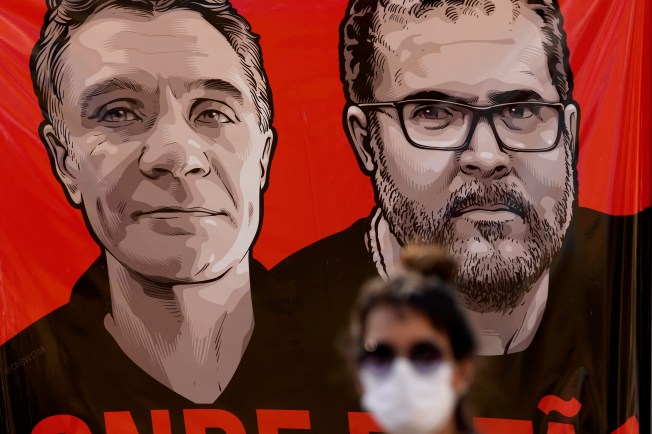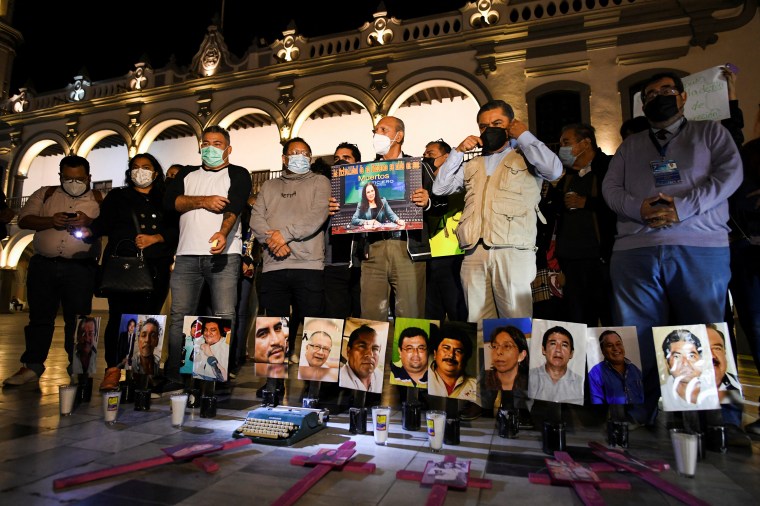By Jennifer Dunham/CPJ Deputy Editorial Director
No one has been held to account in nearly 80% of journalist murders during the last 10 years, CPJ’s 2022 Global Impunity Index found, and governments show little interest in tackling the issue.
Published November 1, 2022
Statistical table | Methodology | Database: All journalists murdered for their work | Press release | Download the PDF
The vast majority of killers of journalists continue to get away with murder, according to CPJ’s 2022 Global Impunity Index. In nearly 80% of the 263 cases of journalists murdered in retaliation for their work globally over the past decade, the perpetrators have faced no punishment.
Somalia remains the worst offender on the index for the eighth straight year. Syria, South Sudan, Afghanistan, and Iraq, respectively, round out the top five countries on the index, which covers the period September 1, 2012, to August 31, 2022. Each of these countries has featured on CPJ’s index multiple times, with their history of conflict, political instability, and weak rule of law underscoring the entrenched nature of impunity and making it unlikely that authorities will ever devote resources to seeking justice for the journalists.
Myanmar makes its first appearance on the index in 2022, its number eight ranking marking another grim milestone after joining the ranks of the world’s worst jailers of journalists in CPJ’s December 1, 2021, prison census. In the wake of the democracy-suspending coup in February 2021, Myanmar’s military junta has jailed dozens of journalists and used sweeping anti-state and false news laws to suppress independent reporting. It also has murdered at least three journalists, including two—Aye Kyaw and Soe Naing—who photographed protests against the regime and later were arrested and killed in custody.
But even in less volatile countries with democratically elected governments, authorities show little political will for prosecuting journalists’ killers or curbing violence against the press. Rather, leaders, such as Mexican President Andrés Manuel López Obrador and Brazilian President Jair Bolsonaro, regularly launch verbal attacks on the media even as reporters face constant threats for their vital reporting on crime, corruption, and environmental issues.
Mexico is one of the most egregious cases. CPJ has documented 28 unsolved journalist murders there in the past 10 years—the most of any country on the index and the Western Hemisphere’s most dangerous for journalists. It ranks sixth on CPJ’s index, in part because the ratings are calculated based on the country’s population size. Further, the complex web of generalized violence in Mexico often makes it difficult to say with certainty whether a journalist’s murder is work-related, meaning deaths with an undetermined motive are not factored into calculations for a country’s placement on CPJ’s index.
At least 13 journalists were killed in Mexico in the first nine months of 2022, the highest number CPJ has ever documented in that country in a single year. At least three of those journalists were murdered in direct retaliation for their reporting on crime and political corruption, and had received threats prior to their deaths. CPJ is investigating the motive in the 10 other killings to determine if they were work-related.
Mexican authorities earlier this year flaunted the high number of suspects arrested in killings of journalists, with presidential spokesperson Jesús Ramírez Cuevas noting in March that 16 people had been detained in connection with the killings of six journalists thus far in 2022. Following recent key convictions in the high-profile 2017 murder of Javier Valdez Cárdenas, authorities also have intensified their efforts to extradite from U.S. custody the alleged mastermind, Dámaso López Serrano, a former high-ranking member of an organized crime group in the northern Mexican state of Sinaloa. Overall, however, the higher arrest rate has not yet led to convictions. In addition, some of those arrested—such as suspects in the 2021 murder of journalist Jacinto Romero Flores—have since been released due to lack of evidence.

In Brazil—which ranked ninth on the index—several events in 2022 drove home the persistent risks for reporters in the country. In June, British journalist Dom Phillips and Indigenous issues expert Bruno Pereira were murdered in the Amazon by people whom police suspect have ties to illegal fishing in the region. Their high-profile murders spotlighted the dangers faced by journalists covering the Amazon and the environmental beat in general. Earlier, in February, the murder of community journalist Givanildo Oliveira by alleged members of the criminal organization known as the Red Command raised concerns about the increasing risks faced by reporters in Brazil’s favelas and marginalized communities.
Meanwhile, the family of Brazilian sports journalist Valério Luiz de Oliveira, who was murdered in 2012 in retaliation for his reporting on a prominent football club, faced another setback in their pursuit of justice as the scheduled 2022 trial dates for his alleged killers were delayed repeatedly. His son, lawyer Valério Luiz de Oliveira Filho, spoke to CPJ about his decade-long fight to ensure that his father’s killers faced justice, which he described as “a never-ending nightmare.”
In the Philippines—which ranked seventh on the index—the election of President Ferdinand Marcos Jr. brought hope of a shift away from outgoing President Rodrigo Duterte’s campaign of intimidation and harassment of the press. However, the murders of two radio commentators—Percival Mabasa, a vocal critic of Duterte and Marcos Jr., and Renato Blanco, who reported on local politics and corruption—since Marcos Jr. took office in late June raised fears that the culture of violence and impunity will endure.

Pakistan and India were ranked 10th and 11th on the index, respectively. Both have appeared on the index every year since CPJ first started compiling it in 2008, demonstrating the persistent nature of impunity and violence against the press in these countries.
During the current 10-year index period, from September 1, 2012, to August 31, 2022, CPJ found that 263 journalists were murdered in retaliation for their work worldwide. In 206 of those cases, or 78%, CPJ recorded complete impunity, meaning no one has been convicted in connection with the crime. For the previous index period (September 1, 2011, to August 31, 2021), CPJ found that 81% of journalist murders were unsolved.
This edition of the index overlaps with the same time period as the United Nations Plan of Action on the Safety of Journalists and the Issue of Impunity, a mechanism launched in 2012 to develop programs to protect journalists and combat impunity in cases of anti-press violence. The plan’s measures include establishing a coordinated interagency mechanism to handle issues related to the safety of journalists, as well as assisting countries to develop legislation and mechanisms favorable to freedom of expression and information, and supporting their efforts to implement existing international rules and principles. Its implementation began in early 2013, yet the index shows that the challenge of impunity remains overwhelming.
CPJ and partner organizations have joined forces in several recent initiatives to combat impunity around the world. One, the “A Safer World For The Truth” project, investigates cold cases of murdered journalists, uncovering new information and advocating for domestic criminal proceedings to be reopened. Earlier this year, at the project’s People’s Tribunal in The Hague, witnesses gave testimony on the 2009 murder of Sri Lankan journalist Lasantha Wickrematunge, and presented an abundance of evidence pointing to the culpability in the killing of the Ministry of Defense—led at the time by Gotabaya Rajapaksa, who resigned as the country’s president in July.

Russia and Bangladesh dropped off this year for the first time since CPJ started the index in 2008 because those countries had three and four unsolved murders in the index period, respectively, below the cutoff of five required for inclusion in the report. But this does not mean that the press freedom or journalist safety environment has improved in these countries. Bangladesh continues to jail journalists under the Digital Security Act, and one—Mushtaq Ahmed—died in jail under unclear circumstances in 2021, after allegedly suffering physical abuse in police custody. Ahmed’s co-accused, cartoonist Kabir Kishore, told CPJ that he was tortured in custody.
Russia has long ranked among the worst countries in the world for journalist murders, with reporters covering beats such as official corruption and human rights violations routinely targeted for their work. Since Vladimir Putin assumed power in late 1999, at least 25 journalists have been murdered in direct retaliation for their work. However, in recent years, targeted killings of journalists have declined as the space for independent reporting has narrowed. That space has almost completely closed since Russia’s full-scale invasion of Ukraine in February, with most of the remaining outlets shutting down under legal and regulatory pressure and thousands of journalists fleeing the country amid a crackdown that has been disastrous for the press in Russia.
Novaya Gazeta was once one of Russia’s leading investigative outlets, and at least six of its journalists and contributors were killed in connection with their brave reporting since 2000. However, in 2022, the outlet, like hundreds of others, can no longer meaningfully operate in Russia due to the complex threats noted above. As Nobel Prize laureate and Novaya Gazeta editor-in-chief Dmitry Muratov said in September, “In Russia, the genocide of media has come to its conclusion. Russian citizens are left alone in the face of government propaganda.”
Statistical table
| Index rank | Country | Unsolved murders | Population (in millions)* | Years on index |
|---|---|---|---|---|
| 1 | Somalia | 19 | 16.4 | 15 |
| 2 | Syria | 16 | 18.3 | 9 |
| 3 | South Sudan | 5 | 11.4 | 8 |
| 4 | Afghanistan | 17 | 39.8 | 14 |
| 5 | Iraq | 17 | 41.2 | 15 |
| 6 | Mexico | 28 | 130.3 | 15 |
| 7 | Philippines | 14 | 111 | 15 |
| 8 | Myanmar | 5 | 54.8 | 1 |
| 9 | Brazil | 13 | 214 | 13 |
| 10 | Pakistan | 9 | 225.2 | 15 |
| 11 | India | 20 | 1393.4 | 15 |
Methodology
CPJ’s Global Impunity Index calculates the number of unsolved journalist murders as a percentage of each country’s population. For this index, CPJ examined journalist murders that occurred between September 1, 2012, and August 31, 2022, and remain unsolved. Only those nations with five or more unsolved cases are included on the index. CPJ defines murder as the targeted killing of a journalist, whether premeditated or spontaneous, in direct reprisal for the journalist’s work. This index does not include cases of journalists killed in combat or while on dangerous assignments, such as coverage of protests that turn violent. Cases are considered unsolved when no convictions have been obtained, even if suspects have been identified and are in custody. Cases in which some but not all suspects have been convicted are classified as partial impunity. Cases in which the suspected perpetrators were killed during apprehension also are categorized as partial impunity. The index only tallies murders that have been carried out with complete impunity. It does not include those for which partial justice has been achieved. Population data from the World Bank’s 2021 World Development Indicators, viewed in September 2022, were used in calculating each country’s rating.
Jennifer Dunham is CPJ’s deputy editorial director. Prior to joining CPJ, she was research director for Freedom House’s Freedom in the World and Freedom of the Press reports.
